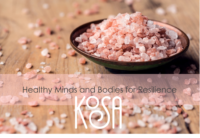wisdom
self-massage (abhyanga)
by Sarah Klinzing-Le, Licensed Massage Therapist
Abhyanga is derived from abhi, meaning "into" or "glow," and anga meaning "limb."
This essential Ayurvedic practice involves the application of generous amounts of warm oil on the skin. The Sanskrit word for oil, “Sneha”, is also the Sanskrit word for love. Ayurveda teaches us that being saturated with oil has a similar effect as being filled with love. Abhyanga is an important part of your self-care routine and is best performed in the morning after garshana (dry body brushing) and before a warm shower or bath.
Read below for the full how-to and see Sarah's video demonstration.
For the latest:
Subscribe to our YouTube channel or IGTV for the latest Self-Care Ritual videos.
Take our Dosha Quiz
Purchase appropriate oil for your constitution (dosha) in our online boutique
Sign up for our newsletter the latest Self-Care Ritual postings
BENEFITS
There are many benefits to performing regular Abhyanga. Regularly oiling the skin helps keep it soft and supple, and oiling the scalp and hair will make your hair shiny and lustrous. But, the benefits to the skin go further than that. Ayurveda and Traditional Chinese Medicine have long regarded the skin, our largest organ, to be a vital part of our immune system. Modern science informs us that these millennia-old wisdoms were correct. We have billions of beneficial microbes on our skin. In the symbiotic human-microbe relationship, sebum (the oil our skin naturally produces) and applied oils feed the microbes and the microbes in turn boost our immune response and help protect the skin from non-beneficial microbes. When we keep our skin well-moisturized with natural, organic oils, we are keeping our microbial allies happy and healthy, and they in turn help to keep us healthy as well.
Abhyanga is also beneficial to the different systems of the body. With this list of benefits, it is a central part of every daily practice, or Dinacharya. Beyond skin benefits, Abhyanga:
- Calms the nervous system and improves sleep
- Increases the production of oxytocin, or the “loving” hormone, and lowers stress hormones
- Increases the circulation of both blood and lymph, bringing blood flow to all areas of the body and assisting in the removal of toxins
- Lubricates the joints, increases flexibility, and helps to tone the muscles of the arms and legs
- Stimulates the internal organs to promote healthy digestion
SUPPLIES
To give yourself an Abhyanga, you’ll need clean hands and:
- Organic Abhyanga oil (based on your dosha)
- A vessel with hot water
- A small glass bottle to hold your organic Abhyanga oil
- A towel – one you don’t mind getting oil on – to sit on during and after your Abhyanga.
INSTRUCTION
From an Ayurvedic perspective, Abhyanga balances the three doshas by calming Vata, soothing Pitta, and stimulating Kapha. You should try to give yourself an Abhyanga 2-5 times a week, depending on your predominant dosha. Vata types benefit from performing self-Abhyanga at least 4-5 times a week, Pitta types should aim for 3-4 times per week, and Kapha types 2-3 times per week.
Follow these steps or watch the video below for a demonstration:
- Warm your oil by placing your glass oil bottle into your hot water vessel.
- Take a deep breath and center yourself in gratitude and the intention of self-love. Remain in this loving awareness throughout your Abhyanga for maximum benefits.
- Using light to moderate pressure*, the general rule is to work from your head to your feet and from right to left. Use long strokes on the long bones and circles around the joints of your arms and legs.
- Clockwise circles on your abdomen will encourage healthy digestion.
- Spend extra time on the scalp, ears, hands, and feet, as there are high concentrations of nerve endings in each of these areas.
- The Abhyanga itself should take 10-15 minutes, but we encourage you to rest and allow the oil to remain on your skin for another 10-15 minutes before taking a warm shower or bath so the oil can penetrate deeper into the body’s tissues.
- Apply shampoo directly to your hair before wetting it, as this will clean the oil off your hair more easily. Avoid using harsh soaps that will strip the skin of the oil’s benefits, and blot dry with a towel after your shower instead of rubbing your skin too vigorously.
*Vata types should make sure to keep their strokes slow and their pressure light as this provides the most grounding for Vata. Pitta types can use slow strokes with a more moderate pressure, and Kapha types can massage the oil in with a faster pace to provide stimulation.
To prevent a slippery shower floor and a slow drain, you can squirt a few drops of dish soap or sprinkle baking soda and vinegar on your shower floor at the end of your shower.
You can take our Dosha Quiz and purchase an appropriate oil for your individual constitution in our online boutique.
Take good care of yourselves and your loved ones. We look forward to serving you in the future, but for the time being, there are many things you can do to support your own well-being. Giving yourself regular Abhyanga is one of those things. We hope this instruction grounds and centers you.
Watch Sarah's video below. Subscribe to our YouTube channel for more Self-Care Ritual videos.
Sign up for our newsletter to receive updates on the latest Self-Care Ritual postings.
next:
building resilience and immunity

Ultimately, we are all exposed to the same things, but those who have a regular practice of self-care, focusing on the whole body and mind, will be resilient.

